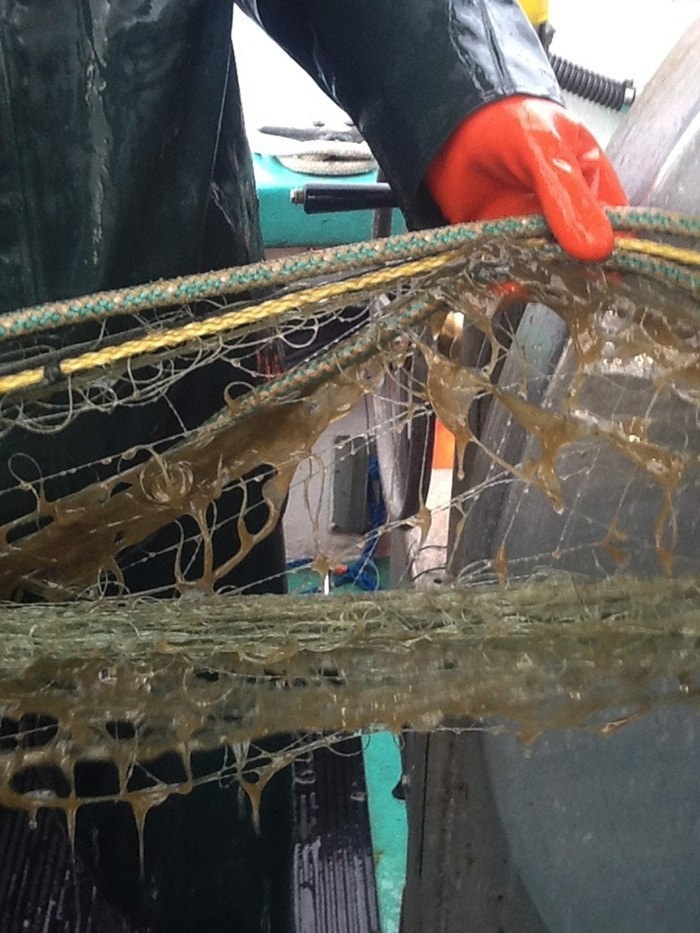The Prince Rupert gill net fleet has been hit hard by a massive algae bloom and may be forced off the water.
“It’s crippling me as far as catching fish goes. Everything on the boat is dirty from [algae] including me and you can’t catch any fish because they can see the net, it’s like a blanket out there,” said Claude McDonald, 76, a gill net fisherman based in Prince Rupert.
A sticky, thick algae is being singled out as the reason for extremely dismal salmon catches so far this season.
Mud is the name given to the plankton by fisherman due to its thick viscosity and muddy colour.
Since learning of the impact the mud is having on their nets, only a fraction of gillnetters are taking the trip north for the salmon openings, gill netter Glen Scoular, 57, said.
“It was so hopeless last [opening], the net was so dirty and hard to clean, we didn’t even go and we haven’t made anything yet.”
McDonald describes the substance as abnormally thick, yet invisible from a boat.
“But once the net has been in the water for five minutes it’s completely plugged. It’s hard to wash out and even with a high pressure water hose it takes hours. We’re not catching any fish, we’re down to less than 20 per cent earnings for June. Algae bloom has been bad before but never as bad as it is right now. As long as I’ve been fishing there’s been some but you would just move to a different spot. Now there’s no other places to go, it’s just everywhere,” said McDonald, whose been fishing more than 60 years.
Another fisherman, Bill Dockar, 61, said not getting fish in the net soon may have some long-term repercussions.
“Commercial fishing licences go for $50,000 - $60,000 plus the cost of the boat can range from $50,000 to $100,000 [or more]. You also need a licence for each area you fish, so to fish down the coast you need three, all with an annual cost of $760. It’s not a cheap sport to get into. Catching nothing [means] you go into the hole,” Dockar said.
In the Prince Rupert harbour, gill net fisherman are not the only ones feeling the impact of the muddy plankton.
Canning at the Canadian Fish Corporation (CANFISCO) started July 8.
“It’s the first time we’ve started this late since I can remember,” Lori Wilson, plant manager, said.
“We just haven’t had any fish. Both plants are now open but normally we would have been canning mid June and today is our first day,” Wilson said.
CANFISCO’s vice president of production and corporate development, Rob Morley said the company still expects larger fish volumes to come from Area 6 closer to Hartley Bay.
“So far the fishing has been slow in northern B.C. but the Skeena hasn’t opened up yet and hopefully things will pick up when it does. Clearly, [the algae bloom] has been interfering with gill nets up the Nass but in a couple weeks from now until we get into bigger areas it’s speculation. We don’t really know the impact until we get out there.”
Research scientist with the Fisheries and Oceans Canada (DFO), Ian Perry, specializes in fisheries oceanography and says record-breaking temperatures are to blame for the spike in algae.
“We’re seeing a lot of unusual things going on at the moment. In general, they are related to weather and unusually warm water temperatures. What we see as a result is a very unusual bloom of phytoplankton which extends from southern California up to the tip of Vancouver Island, some of it is also being observed off Alaska south of Anchorage [in the Nass].”
Samples of the Nass phytoplankton has been collected for analysis.
“The blooms off the west coast of Vancouver Island are different, its not the same species. [Samples from the Nass] were sent to us on Saturday and from what I’ve seen from pictures I don’t think they are toxic but we won’t really know until the samples get here,” he said, adding thick algae is not what’s unusual, but the high volume.
“Every year at the DFO we get together with people inside and outside the department [to talk] about the state of the ocean. We put together a report and this year’s should be out any day about the conditions in 2014 leading up to 2015. It talks about warmer water and a huge blob of warm water in the Gulf of Alaska that moved to the shore on the coast [last year] during the October to December time period and how it stayed along the coast causing some record high water temperatures in 2015 including near the light house station on Langara Island north of Haida Gwaii and all down the central and south coasts,” Perry said.
The primary source of information for DFO about abnormalities in the ocean comes from the public, Perry added.
